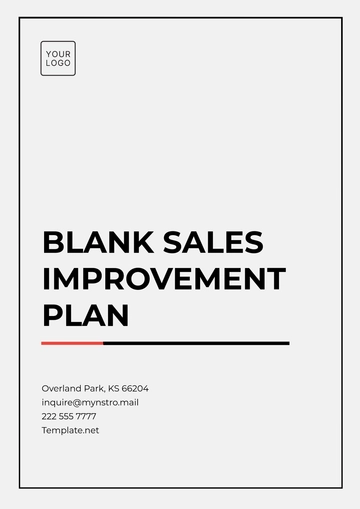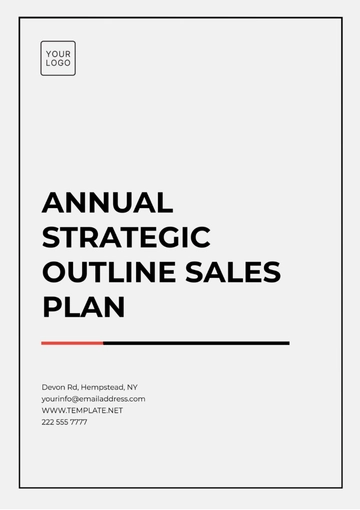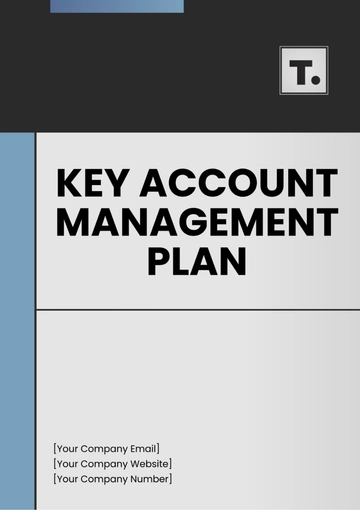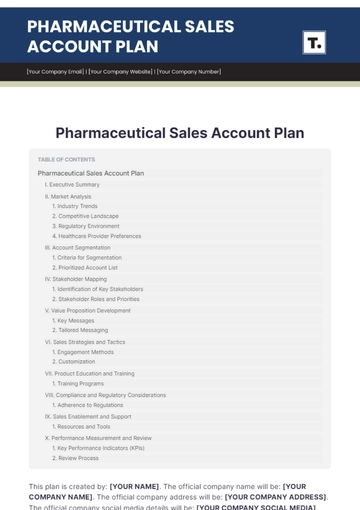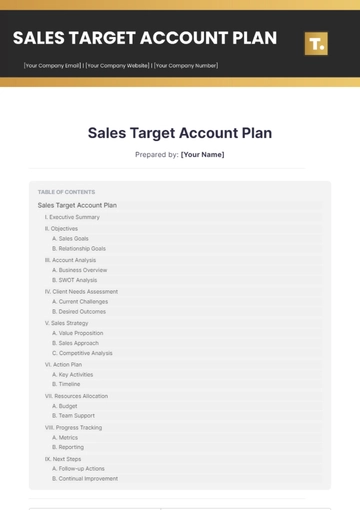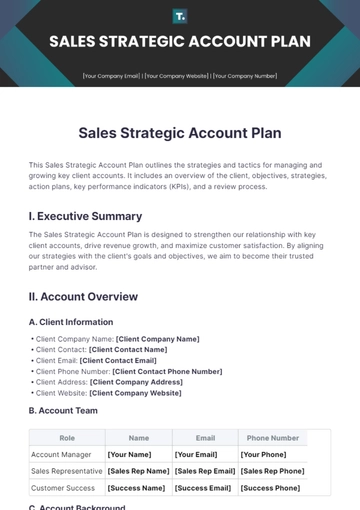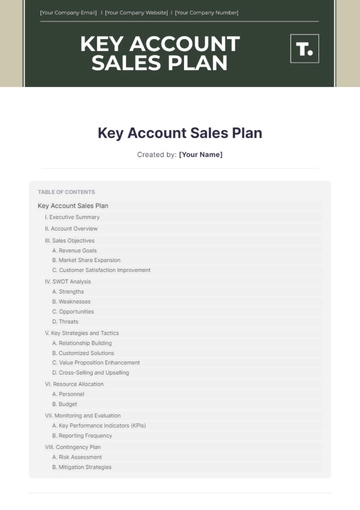Free Sales Strategic Account Review and Future Plan

And Future Plan
Introduction
The purpose of this document is to present a detailed assessment of the Sales Strategic Account activities of [Your Company Name] for the fiscal year [Year]-[Year]. As strategic accounts form the cornerstone of our business, it is crucial to periodically review their performance and plan for future engagement. This review will cover key performance indicators, sales performance metrics, customer engagement statistics, and a SWOT analysis. The latter part of this document will outline future strategies designed to further improve and expand our strategic account management.
Executive Summary
This document offers an in-depth analysis and strategic review of Sales Strategic Account initiatives within [Your Company Name] for the fiscal year [Year]-[Year]. The report subsequently outlines a multi-faceted approach for future strategies aimed at augmenting profitability, enhancing customer engagement, and mitigating risks. Executives and stakeholders are encouraged to consider the findings and recommendations herein to make data-driven decisions for sustainable growth.
Objectives and KPIs
The primary objective for the fiscal year [Year]-[Year] is to augment sales revenue from strategic accounts by [00]%. Achieving this growth will necessitate targeted initiatives designed to deepen engagement, increase customer retention, and maximize the lifetime value of each strategic account. Sub-objectives include:
Aim for a [0]% increase in the customer retention rate for strategic accounts.
Boost customer engagement rates by at least 5%.
Strive for a [00]% improvement in CLV.
Enhance NPS by [0] points, reflecting improved customer satisfaction and loyalty.
Key Performance Indicators:
To measure the success of our objectives, the following KPIs have been identified. Each KPI is stringently aligned with one or more specific objectives, thus allowing for a holistic evaluation of our strategic accounts program. The following elaborates on each KPI:
Sales Revenue from Strategic Accounts: Serving as the quintessential measure of our primary objective, this KPI will be scrutinized on a monthly, quarterly, and annual basis. Revenue growth from strategic accounts provides a direct measure of the success of our sales and marketing initiatives.
Customer Retention Rate: Given its critical role in sustainable revenue generation, the Customer Retention Rate will be monitored quarterly and annually. An upward trend in this metric correlates strongly with customer satisfaction and with the long-term value derived from strategic accounts.
Customer Lifetime Value (CLV): To quantify the aggregate revenue expected from each strategic account over the entirety of its relationship with [Your Company Name], CLV will be calculated annually.
Net Promoter Score (NPS): This widely recognized metric offers insights into customer loyalty and sentiment, serving as an indirect but powerful indicator of revenue sustainability.
Customer Engagement Rate: In order to assess the efficacy of our engagement strategies, metrics such as email open rates and click-through rates will be tracked monthly. A consistent or increasing engagement rate signals the resonance of our value proposition with our customer base.
Account Health Score: This composite metric incorporates various parameters, including but not limited to product usage, customer interaction, and feedback. It provides a quick, quarterly snapshot of account vitality.
Sales Performance Review
The Sales Performance Review aims to provide an exhaustive analysis of the fiscal year [Year]-[Year] with respect to the operations and outcomes of strategic accounts. This analysis is broken down into several categories, each of which is critically examined to determine performance levels, identify pain points, and recognize areas of opportunity.
Revenue Performance:
Quarter | Percentage Change from Previous Quarter |
|---|---|
Q1 | - |
Q2 | +8.8% |
Q3 | |
Q4 |
During the fiscal year [Year]-[Year], revenue generated from strategic accounts saw an increase of [00]%, almost meeting the annual target of [00]%. Although the growth is commendable, it necessitates a closer look into why the set objective was narrowly missed.
Customer Segmentation and Revenue Contribution:
An analysis of revenue by customer segments within strategic accounts reveals that [00]% of revenue was generated by Tier 1 accounts, [00]% by Tier 2, and the remaining [00]% by Tier 3 accounts.
Product Performance in Strategic Accounts:
The top-performing product in strategic accounts was Product A, contributing to [00]% of the total revenue, followed by Product B and Product C, contributing [00]% and [00]%, respectively.
Challenges and Opportunities
Although revenue growth was significant, challenges such as market volatility and increasing competition were evident. These aspects have marginally impacted our revenue targets and will be areas of focus moving forward.
Key Takeaways
Revenue growth was strong but fell slightly short of the annual objective.
Tier 1 accounts continue to be the primary revenue drivers, warranting sustained focus.
Product A remains the highest contributor to revenue among strategic accounts.
By scrutinizing these facets of sales performance, [Your Company Name] aims to formulate data-backed strategies to optimize future revenue potential and customer satisfaction in strategic accounts.
Customer Engagement Metrics
This section aims to provide an in-depth evaluation of how effectively [Your Company Name] engages with its strategic accounts. Engagement is a pivotal factor that transcends the simplistic transactional relationship and goes into the realm of building loyalty, value, and long-term partnership. The metrics discussed below offer a comprehensive view of this critical aspect of our business.
Engagement Rate:
The average engagement rate for the fiscal year [Year]-[Year] was [00]%, marking a [00]% increase from the previous year. This signifies a positive trajectory, albeit with room for further enhancement.
Month | Engagement Rate |
|---|---|
January | 65% |
February | 68% |
March | |
April | |
May | |
June | |
July | |
August | |
September | |
October | |
November | |
December |
Net Promoter Score:
NPS for strategic accounts ascended from [00] in the previous fiscal year to [00] this year. While the upward trend is encouraging, the score suggests room for elevating customer satisfaction and loyalty further.
Quarter | NPS |
|---|---|
Q1 | 52 |
Q2 | |
Q3 | |
Q4 |
Social Media Engagement:
On average, social media platforms recorded [0,000] interactions per month across all platforms. These statistics represent a healthy yet underexploited channel for customer engagement.
Month | Interactions |
|---|---|
January | 4,800 |
February | 5,100 |
March | |
April | |
May | |
June | |
July | |
August | |
September | |
October | |
November | |
December |
This data-driven insight will serve as the cornerstone for formulating strategies aimed at intensifying customer engagement, thereby positively influencing both revenue generation and customer loyalty in strategic accounts.
Future Strategies
The section serves as a blueprint for navigating the complexities and seizing the opportunities in the strategic account landscape for fiscal years [Year]-[Year]. Drawing on key insights from historical performance and current market trends, [Your Company Name] is committed to implementing a multi-pronged strategy designed to elevate every facet of our engagement with strategic accounts.
Revenue Growth and Diversification: Given the minor shortfall in revenue objectives in the previous fiscal year, the focus will be on not just growing revenue but also diversifying the revenue streams. This includes expanding our product portfolio within existing accounts and penetrating new verticals.
Enhancing Customer Engagement: Strategies aimed at increasing customer engagement will revolve around hyper-personalized marketing campaigns, community building, and leveraging advanced analytics to predict customer behavior and preferences.
Account Retention and Expansion: High-performing accounts will be identified for expansion through upselling and cross-selling strategies, while at-risk accounts will be subject to rigorous retention strategies involving contractual incentives and increased customer touchpoints.
Key Considerations for Implementation:
The strategies will be implemented in a phased manner to allow for mid-course corrections based on interim performance metrics.
Investments in technology, particularly in Customer Relationship Management (CRM) and analytics platforms, will be crucial for the successful execution of these strategies.
Conclusion
The sales strategic account initiatives for [Your Company Name] in the fiscal year [Year]-[Year] have yielded promising results. The key performance indicators show a consistent uptrend, but there are areas for improvement and expansion. The outlined future strategies aim to capitalize on strengths and opportunities while mitigating weaknesses and threats.
- 100% Customizable, free editor
- Access 1 Million+ Templates, photo’s & graphics
- Download or share as a template
- Click and replace photos, graphics, text, backgrounds
- Resize, crop, AI write & more
- Access advanced editor
Keep your high-value accounts thriving and alive with our Sales Strategic Account Review and Future Plan Template. This easy-to-use document, editable via our AI Editor Tool, can aid your company in assessing past performance and setting actionable future goals for your key client accounts. Get this customizable template now at Template.net!
You may also like
- Finance Plan
- Construction Plan
- Sales Plan
- Development Plan
- Career Plan
- Budget Plan
- HR Plan
- Education Plan
- Transition Plan
- Work Plan
- Training Plan
- Communication Plan
- Operation Plan
- Health And Safety Plan
- Strategy Plan
- Professional Development Plan
- Advertising Plan
- Risk Management Plan
- Restaurant Plan
- School Plan
- Nursing Home Patient Care Plan
- Nursing Care Plan
- Plan Event
- Startup Plan
- Social Media Plan
- Staffing Plan
- Annual Plan
- Content Plan
- Payment Plan
- Implementation Plan
- Hotel Plan
- Workout Plan
- Accounting Plan
- Campaign Plan
- Essay Plan
- 30 60 90 Day Plan
- Research Plan
- Recruitment Plan
- 90 Day Plan
- Quarterly Plan
- Emergency Plan
- 5 Year Plan
- Gym Plan
- Personal Plan
- IT and Software Plan
- Treatment Plan
- Real Estate Plan
- Law Firm Plan
- Healthcare Plan
- Improvement Plan
- Media Plan
- 5 Year Business Plan
- Learning Plan
- Marketing Campaign Plan
- Travel Agency Plan
- Cleaning Services Plan
- Interior Design Plan
- Performance Plan
- PR Plan
- Birth Plan
- Life Plan
- SEO Plan
- Disaster Recovery Plan
- Continuity Plan
- Launch Plan
- Legal Plan
- Behavior Plan
- Performance Improvement Plan
- Salon Plan
- Security Plan
- Security Management Plan
- Employee Development Plan
- Quality Plan
- Service Improvement Plan
- Growth Plan
- Incident Response Plan
- Basketball Plan
- Emergency Action Plan
- Product Launch Plan
- Spa Plan
- Employee Training Plan
- Data Analysis Plan
- Employee Action Plan
- Territory Plan
- Audit Plan
- Classroom Plan
- Activity Plan
- Parenting Plan
- Care Plan
- Project Execution Plan
- Exercise Plan
- Internship Plan
- Software Development Plan
- Continuous Improvement Plan
- Leave Plan
- 90 Day Sales Plan
- Advertising Agency Plan
- Employee Transition Plan
- Smart Action Plan
- Workplace Safety Plan
- Behavior Change Plan
- Contingency Plan
- Continuity of Operations Plan
- Health Plan
- Quality Control Plan
- Self Plan
- Sports Development Plan
- Change Management Plan
- Ecommerce Plan
- Personal Financial Plan
- Process Improvement Plan
- 30-60-90 Day Sales Plan
- Crisis Management Plan
- Engagement Plan
- Execution Plan
- Pandemic Plan
- Quality Assurance Plan
- Service Continuity Plan
- Agile Project Plan
- Fundraising Plan
- Job Transition Plan
- Asset Maintenance Plan
- Maintenance Plan
- Software Test Plan
- Staff Training and Development Plan
- 3 Year Plan
- Brand Activation Plan
- Release Plan
- Resource Plan
- Risk Mitigation Plan
- Teacher Plan
- 30 60 90 Day Plan for New Manager
- Food Safety Plan
- Food Truck Plan
- Hiring Plan
- Quality Management Plan
- Wellness Plan
- Behavior Intervention Plan
- Bonus Plan
- Investment Plan
- Maternity Leave Plan
- Pandemic Response Plan
- Succession Planning
- Coaching Plan
- Configuration Management Plan
- Remote Work Plan
- Self Care Plan
- Teaching Plan
- 100-Day Plan
- HACCP Plan
- Student Plan
- Sustainability Plan
- 30 60 90 Day Plan for Interview
- Access Plan
- Site Specific Safety Plan


